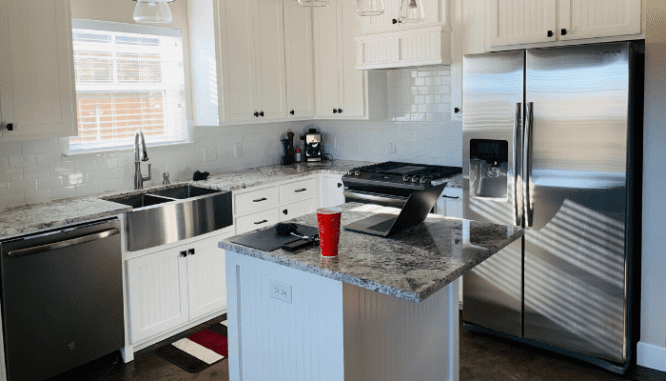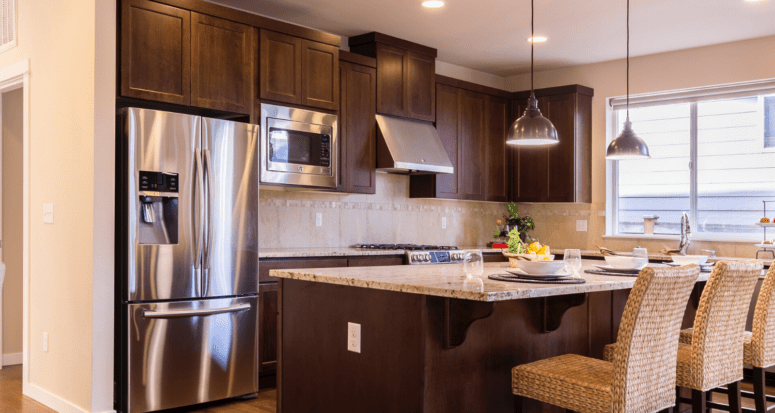Do Stainless Steel Appliances Increase Home Value Or Are They Just Pretty to Look At?
- Published on
- 4 min read
-
 Valerie Kalfrin Contributing AuthorClose
Valerie Kalfrin Contributing AuthorClose Valerie Kalfrin Contributing Author
Valerie Kalfrin Contributing AuthorValerie Kalfrin is a multiple award-winning journalist, film and fiction fan, and creative storyteller with a knack for detailed, engaging stories.
At HomeLight, our vision is a world where every real estate transaction is simple, certain, and satisfying. Therefore, we promote strict editorial integrity in each of our posts.
Not all that glitters is gold — especially in the kitchen, where stainless steel appliances reign supreme.
Even among new trends like matte black appliances and bright colors like red, traditional stainless steel appliances are still hot in the kitchen. In fact, according to a recent HomeLight survey of 435 top agents nationwide, 75% say that stainless steel is the most in-demand finish among buyers.
“All things being equal, it will make a house sell faster. Buyers go for stainless every time,” said Patricia Anderson, a top real estate agent serving the Louisiana corridor between Baton Rouge and New Orleans. Anderson and her husband even have stainless steel appliances in the home they had built in 2007.
“It’s shiny, pretty, and looks clean and crisp — and goes well with everything.”
If you’re considering renovating your kitchen before putting your home on the market, you might wonder if stainless steel appliances increase home value. But before you head to the home center to scope out the latest stainless steel stoves, microwaves, dishwashers, and refrigerators, let’s check out a few other factors to help you decide whether to go all-in on this finish or put it on the back burner.

Stainless steel: A modern look that’s durable and hygienic
Before the early 2000s, you were more likely to spot utilitarian stainless steel appliances in a restaurant or other commercial kitchen than in your neighbor’s. But the turn of the millennium, complete with its “glittering utopian futurism,” inspired a wave of shiny fashion and furnishings, including stainless steel appliances that brought the future home.
People used to like commercial-grade stainless steel appliances in part because they symbolized that “you were a serious cook,” noted The Atlantic. But once the look caught on, especially among high-end buyers, stainless steel became more of a status symbol.
Stainless steel still evokes a sleek, modern look, and statistics from the Association of Home Appliance Manufacturers show that it hasn’t dipped in popularity. Shipments of stainless side-by-side refrigerators increased 25% from 2010 to 2015. What’s more, shipments of stainless gas ranges and dishwashers both rose 23% during those five years. Stainless bottom-mount refrigerators were the most popular of all kitchen appliances tracked in these statistics, with shipments growing 32% during this time period.
So, what makes stainless steel appliances so enticing?
- They’re neutral:
A stainless steel finish complements any decor and appeals to both men and women, according to the design blog Architecture Restoration. - They’re durable:
Because it’s an alloy, or a mixture of metals and other materials to increase strength and resist corrosion and heat, stainless steel doesn’t easily show rust, water damage, or wear and tear. - They’re hygienic:
Germs have a tough time sticking to stainless steel, according to the International Stainless Steel Forum, a nonprofit research organization founded in 1996. That makes the material not only a natural choice for the health industry but for the sanitary conditions required for food processing, which also boosts its consumer appeal.
Stainless steel can be expensive, and ‘spotty’
Stainless steel appliances do have a few drawbacks. Because of their popularity, they can be pricier than other finishes (though you can find a good sale, depending on the store and time of year). For instance, a stainless steel Frigidaire 20.4 cubic-foot refrigerator with a top freezer costs about $853 at Home Depot, roughly $100 more than the white finish.
Whirlpool’s “fingerprint resistant” metallic steel 17.6 cubic-foot refrigerator with a top freezer was on sale recently for about $790 at Lowe’s (regular price: $879). The white finish in the same model was also on sale: $692 (regular price: $729).
That fingerprint resistance is definitely a perk. Although stainless steel itself isn’t magnetic, the front of these appliances tends to collect fingerprints, water spots, streaks, and smudges; All of which stand out against that shiny background.
The agents in HomeLight’s survey were divided on whether buyers would pay more for a lower-maintenance “fingerprint resistant” finish on stainless steel. About 36% thought buyers would while roughly 34% said no, and about 30% of respondents weren’t sure. That said, more than one homeowner (whether online or just talking among friends) has said they feel like they’re constantly wiping down these appliances to keep them looking fresh.
(Speaking of which, although you can use an all-in-one cleaner, like Weiman Stainless Steel Cleaner and Polish, which costs about $4.39 for 12 oz., a nonabrasive cotton rag and dish soap also does the trick.)

Is stainless steel worth the upgrade?
Any return on investment depends on how much you spend and where you live. It will also depend on the condition of your current appliances.
- How old are your appliances?
Are your appliances still functioning OK? The average lifespan of a refrigerator is 13 years, according to HouseLogic. A gas range can last about 15 years (13 years for electric), and a dishwasher is good for about nine years.If your freezer isn’t keeping ice cream as cold anymore or rattling every now and then, first check if it’s under warranty for any parts or labor. If not, you’ll have to consider a new one, lest potential buyers think they’re inheriting a problem. - How do your appliances show?
Are your kitchen appliances all the same or similar color, material, or brand? A kitchen will look pulled together, regardless of finish, if the appliances match. Style impresses buyers most, according to the top agents in HomeLight’s survey.They ranked style at 58% among the factors most important to buyers evaluating kitchen appliances, well above quality (29%) and energy efficiency (4%). “If your home’s appliances all match and they’re all in great shape, I wouldn’t spend the money,” Anderson added. - What about the kitchens in properties comparable in price to yours?
The median new home price as of September was $299,400, according to the U.S. Census Bureau. While stainless steel might not be as ubiquitous in entry-level homes, mid-level buyers will expect it. High-end buyers will check for brand names such as Sub-Zero, Miele, Thermador, and Viking. “It’s so widespread now, it’s thought of in buyers’ minds as the upper tier,” Anderson said.
In fact, the top agents in HomeLight’s survey said buyers are about 50% more likely to put an offer on a house with stainless steel appliances than a house without them.

How much can I expect to spend?
According to HomeLight’s top agents, updating to all-new stainless steel appliances (including the dishwasher, stove, range hood, refrigerator, and microwave) could cost an average of $4,229, with an average estimated ROI of $5,982, or 41.5%.
If your appliances are so dated or clunky that they could turn off potential buyers, this is definitely worth discussing and reviewing with your real estate agent to find out how much you can budget for upgrades.
HomeAdvisor.com estimates that the average top-to-bottom kitchen remodel costs $75 to $250 per square foot, including about 14% of the average budget (roughly $3,220) for new appliances and ventilation. (Don’t forget to figure out what to do with your old appliances. Stores such as Home Depot will haul away your old appliance for $25 after delivering a new one. Charities such as the Salvation Army and St. Vincent de Paul sometimes accept appliance donations and can arrange for pickup.)
Appliance costs vary depending on whether they’re EnergyStar-certified (meaning they’re energy-efficient, resulting in lower utility bills) and include features such as Bluetooth capabilities.
For instance, GE’s Profile 6.7 cubic-foot Smart Slide-In Double Oven Gas Range with Self-Cleaning Oven in Stainless Steel costs about $3,000. It includes an 18,000 BTU Power Boil burner to boil water in less time, a one-touch option to sync the clock and range elements, and a Wi-Fi connection so that you can control the oven’s functions from your smartphone.
A family-owned business in the Boston, Massachusetts, area since 1923, Yale Appliance and Lighting — accredited by the Better Business Bureau — recommends several stainless steel appliance packages (range, microwave, refrigerator, and dishwasher) for upgrades across different price ranges.
Among affordable stainless steel appliance packages (from $1,699 to $4,999), they also recommend a Samsung over-the-range microwave, 29-inch top-mount refrigerator, 24-inch dishwasher, and freestanding electric range for roughly $1,800. A similar package from GE that includes a microwave with a convection option and a side-by-side refrigerator runs about $4,300.
For a package of mid-range to affordable luxury appliances (about $3,999 to $7,999), Bosch has a 30-inch slide-in gas convection range, an 1100-watt over-the-range microwave, a French-door counter-depth refrigerator, and an almost-noiseless dishwasher for about $5,800. Jenn-Air has a similar package for about $6,000.
One more thing to consider is how long you expect to remain in your current home. As with any upgrade, you want to be sure you have time to enjoy it before passing it along to someone else.
Even if your home is more than a few years old, the buzzwords of “stainless steel appliances” can signal to buyers that it’s well maintained and turnkey ready. Invite your real estate agent for a chat in your kitchen to determine whether any such renovations are worth cooking up.
Header Image Source: (Francesca Tosolini / Unsplash)
